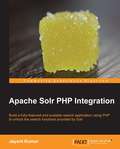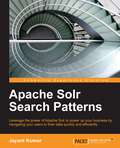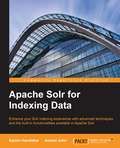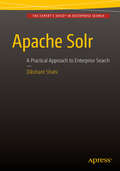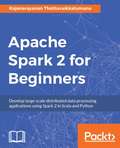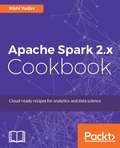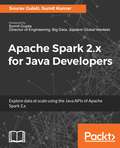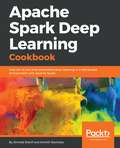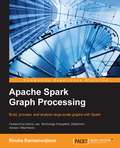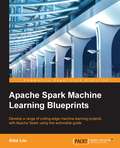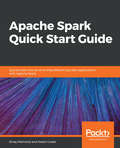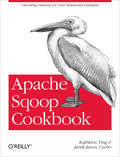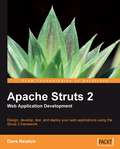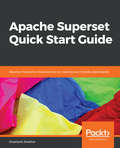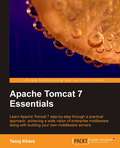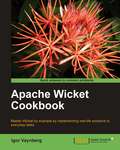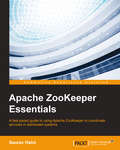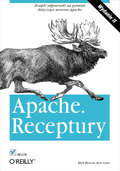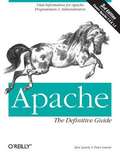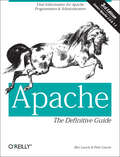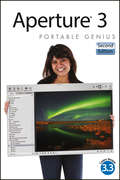- Table View
- List View
Apache Solr PHP Integration
by Jayant KumarThis book is full of step-by-step example-oriented tutorials which will show readers how to integrate Solr in PHP applications using the available libraries, and boost the inherent search facilities that Solr offers.If you are a developer who knows PHP and is interested in integrating search into your applications, this is the book for you. No advanced knowledge of Solr is required. Very basic knowledge of system commands and the command-line interface on both Linux and Windows is required. You should also be familiar with the concept of Web servers.
Apache Solr Search Patterns
by Jayant KumarThis book is for developers who already know how to use Solr and are looking at procuring advanced strategies for improving their search using Solr. This book is also for people who work with analytics to generate graphs and reports using Solr. Moreover, if you are a search architect who is looking forward to scale your search using Solr, this is a must have book for you. It would be helpful if you are familiar with the Java programming language.
Apache Solr for Indexing Data
by Anshul Johri Sachin HandiekarEnhance your Solr indexing experience with advanced techniques and the built-in functionalities available in Apache Solr About This Book * Learn about distributed indexing and real-time optimization to change index data on fly * Index data from various sources and web crawlers using built-in analyzers and tokenizers * This step-by-step guide is packed with real-life examples on indexing data Who This Book Is For This book is for developers who want to increase their experience of indexing in Solr by learning about the various index handlers, analyzers, and methods available in Solr. Beginner level Solr development skills are expected. What You Will Learn * Get to know the basic features of Solr indexing and the analyzers/tokenizers available * Index XML/JSON data in Solr using the HTTP Post tool and CURL command * Work with Data Import Handler to index data from a database * Use Apache Tika with Solr to index word documents, PDFs, and much more * Utilize Apache Nutch and Solr integration to index crawled data from web pages * Update indexes in real-time data feeds * Discover techniques to index multi-language and distributed data in Solr * Combine the various indexing techniques into a real-life working example of an online shopping web application In Detail Apache Solr is a widely used, open source enterprise search server that delivers powerful indexing and searching features. These features help fetch relevant information from various sources and documentation. Solr also combines with other open source tools such as Apache Tika and Apache Nutch to provide more powerful features. This fast-paced guide starts by helping you set up Solr and get acquainted with its basic building blocks, to give you a better understanding of Solr indexing. You'll quickly move on to indexing text and boosting the indexing time. Next, you'll focus on basic indexing techniques, various index handlers designed to modify documents, and indexing a structured data source through Data Import Handler. Moving on, you will learn techniques to perform real-time indexing and atomic updates, as well as more advanced indexing techniques such as de-duplication. Later on, we'll help you set up a cluster of Solr servers that combine fault tolerance and high availability. You will also gain insights into working scenarios of different aspects of Solr and how to use Solr with e-commerce data. By the end of the book, you will be competent and confident working with indexing and will have a good knowledge base to efficiently program elements. Style and approach This fast-paced guide is packed with examples that are written in an easy-to-follow style, and are accompanied by detailed explanation. Working examples are included to help you get better results for your applications.
Apache Solr: A Practical Approach to Enterprise Search
by Dikshant ShahiBuild an enterprise search engine using Apache Solr: index and search documents; ingest data from varied sources; apply various text processing techniques; utilize different search capabilities; and customize Solr to retrieve the desired results. Apache Solr: A Practical Approach to Enterprise Search explains each essential concept--backed by practical and industry examples--to help you attain expert-level knowledge. The book, which assumes a basic knowledge of Java, starts with an introduction to Solr, followed by steps to setting it up, indexing your first set of documents, and searching them. It then introduces you to information retrieval and its implementation in Apache Solr; this will help you understand your search problem, decide the approach to build an effective solution, and use various metrics to evaluate the results. The book next covers the schema design and techniques to build a text analysis chain for cleansing, normalizing and enriching your documents and addressing different types of search queries. It describes various popular matching techniques which are generally applied to improve the precision and recall of searches. You will learn the end-to-end process of data ingestion from varied sources, metadata extraction, pre-processing and transformation of content, various search components, query parsers and other advanced search capabilities. After covering out-of-the-box features, Solr expert Dikshant Shahi dives into ways you can customize Solr for your business and its specific requirements, along with ways to plug in your own components. Most important, you will learn about implementations for Solr scoring, factors affecting the document score, and tuning the score for the application at hand. The book explains why textual scoring is not sufficient for practical ranking of documents and ways to integrate real-world factors for contributing to the document ranking. You'll see how to influence user experience by providing suggestions and recommendations. You'll also see integration of Solr with important related technologies such as OpenNLP and Tika. Additionally, you will learn about scaling Solr using SolrCloud. This book concludes with coverage of semantic search capabilities, which is crucial for taking the search experience to the next level. By the end of Apache Solr, you will be proficient in designing and developing your search engine. What you'll learn How to develop a search engine using Solr How to implement information retrieval concepts How to master search engine internals How to build your search strategy Hot to customize Solr for your unique search problem How to make your search engine intelligent and self-learning Who this book is for Professionals into data mining, data management, or Web development. Table of Contents Chapter 1: Introduction to Search Engines and Solr Chapter 2: Solr Setup and Administration Chapter 3: Understanding Information Retrieval Chapter 4: Search Strategy and Schema Design Chapter 5: Indexing Data Chapter 6: Searching Solr Chapter 7: Advanced Querying Chapter 8: Customizing Document Ranking Chapter 9: Going Beyond Text Matching Chapter 10: SolrCloud Chapter 11: Practical Search Examples
Apache Spark 2 for Beginners
by Rajanarayanan ThottuvaikkatumanaDevelop large-scale distributed data processing applications using Spark 2 in Scala and Python About This Book * This book offers an easy introduction to the Spark framework published on the latest version of Apache Spark 2 * Perform efficient data processing, machine learning and graph processing using various Spark components * A practical guide aimed at beginners to get them up and running with Spark Who This Book Is For If you are an application developer, data scientist, or big data solutions architect who is interested in combining the data processing power of Spark from R, and consolidating data processing, stream processing, machine learning, and graph processing into one unified and highly interoperable framework with a uniform API using Scala or Python, this book is for you. What You Will Learn * Get to know the fundamentals of Spark 2 and the Spark programming model using Scala and Python * Know how to use Spark SQL and DataFrames using Scala and Python * Get an introduction to Spark programming using R * Perform Spark data processing, charting, and plotting using Python * Get acquainted with Spark stream processing using Scala and Python * Be introduced to machine learning using Spark MLlib * Get started with graph processing using the Spark GraphX * Bring together all that you've learned and develop a complete Spark application In Detail Spark is one of the most widely-used large-scale data processing engines and runs extremely fast. It is a framework that has tools that are equally useful for application developers as well as data scientists. This book starts with the fundamentals of Spark 2 and covers the core data processing framework and API, installation, and application development setup. Then the Spark programming model is introduced through real-world examples followed by Spark SQL programming with DataFrames. An introduction to SparkR is covered next. Later, we cover the charting and plotting features of Python in conjunction with Spark data processing. After that, we take a look at Spark's stream processing, machine learning, and graph processing libraries. The last chapter combines all the skills you learned from the preceding chapters to develop a real-world Spark application. By the end of this book, you will have all the knowledge you need to develop efficient large-scale applications using Apache Spark. Style and approach Learn about Spark's infrastructure with this practical tutorial. With the help of real-world use cases on the main features of Spark we offer an easy introduction to the framework.
Apache Spark 2.x Cookbook
by Rishi YadavOver 70 recipes to help you use Apache Spark as your single big data computing platform and master its libraries About This Book • This book contains recipes on how to use Apache Spark as a unified compute engine • Cover how to connect various source systems to Apache Spark • Covers various parts of machine learning including supervised/unsupervised learning & recommendation engines Who This Book Is For This book is for data engineers, data scientists, and those who want to implement Spark for real-time data processing. Anyone who is using Spark (or is planning to) will benefit from this book. The book assumes you have a basic knowledge of Scala as a programming language. What You Will Learn • Install and configure Apache Spark with various cluster managers & on AWS • Set up a development environment for Apache Spark including Databricks Cloud notebook • Find out how to operate on data in Spark with schemas • Get to grips with real-time streaming analytics using Spark Streaming & Structured Streaming • Master supervised learning and unsupervised learning using MLlib • Build a recommendation engine using MLlib • Graph processing using GraphX and GraphFrames libraries • Develop a set of common applications or project types, and solutions that solve complex big data problems In Detail While Apache Spark 1.x gained a lot of traction and adoption in the early years, Spark 2.x delivers notable improvements in the areas of API, schema awareness, Performance, Structured Streaming, and simplifying building blocks to build better, faster, smarter, and more accessible big data applications. This book uncovers all these features in the form of structured recipes to analyze and mature large and complex sets of data. Starting with installing and configuring Apache Spark with various cluster managers, you will learn to set up development environments. Further on, you will be introduced to working with RDDs, DataFrames and Datasets to operate on schema aware data, and real-time streaming with various sources such as Twitter Stream and Apache Kafka. You will also work through recipes on machine learning, including supervised learning, unsupervised learning & recommendation engines in Spark. Last but not least, the final few chapters delve deeper into the concepts of graph processing using GraphX, securing your implementations, cluster optimization, and troubleshooting. Style and approach This book is packed with intuitive recipes supported with line-by-line explanations to help you understand Spark 2.x's real-time processing capabilities and deploy scalable big data solutions. This is a valuable resource for data scientists and those working on large-scale data projects.
Apache Spark 2.x for Java Developers
by Sourav Gulati Sumit KumarUnleash the data processing and analytics capability of Apache Spark with the language of choice: Java About This Book • Perform big data processing with Spark—without having to learn Scala! • Use the Spark Java API to implement efficient enterprise-grade applications for data processing and analytics • Go beyond mainstream data processing by adding querying capability, Machine Learning, and graph processing using Spark Who This Book Is For If you are a Java developer interested in learning to use the popular Apache Spark framework, this book is the resource you need to get started. Apache Spark developers who are looking to build enterprise-grade applications in Java will also find this book very useful. What You Will Learn • Process data using different file formats such as XML, JSON, CSV, and plain and delimited text, using the Spark core Library. • Perform analytics on data from various data sources such as Kafka, and Flume using Spark Streaming Library • Learn SQL schema creation and the analysis of structured data using various SQL functions including Windowing functions in the Spark SQL Library • Explore Spark Mlib APIs while implementing Machine Learning techniques to solve real-world problems • Get to know Spark GraphX so you understand various graph-based analytics that can be performed with Spark In Detail Apache Spark is the buzzword in the big data industry right now, especially with the increasing need for real-time streaming and data processing. While Spark is built on Scala, the Spark Java API exposes all the Spark features available in the Scala version for Java developers. This book will show you how you can implement various functionalities of the Apache Spark framework in Java, without stepping out of your comfort zone. The book starts with an introduction to the Apache Spark 2.x ecosystem, followed by explaining how to install and configure Spark, and refreshes the Java concepts that will be useful to you when consuming Apache Spark's APIs. You will explore RDD and its associated common Action and Transformation Java APIs, set up a production-like clustered environment, and work with Spark SQL. Moving on, you will perform near-real-time processing with Spark streaming, Machine Learning analytics with Spark MLlib, and graph processing with GraphX, all using various Java packages. By the end of the book, you will have a solid foundation in implementing components in the Spark framework in Java to build fast, real-time applications. Style and approach This practical guide teaches readers the fundamentals of the Apache Spark framework and how to implement components using the Java language. It is a unique blend of theory and practical examples, and is written in a way that will gradually build your knowledge of Apache Spark.
Apache Spark Deep Learning Cookbook: Over 80 recipes that streamline deep learning in a distributed environment with Apache Spark
by Ahmed Sherif Amrith RavindraA solution-based guide to put your deep learning models into production with the power of Apache SparkKey FeaturesDiscover practical recipes for distributed deep learning with Apache SparkLearn to use libraries such as Keras and TensorFlow Solve problems in order to train your deep learning models on Apache SparkBook DescriptionWith deep learning gaining rapid mainstream adoption in modern-day industries, organizations are looking for ways to unite popular big data tools with highly efficient deep learning libraries. As a result, this will help deep learning models train with higher efficiency and speed. With the help of the Apache Spark Deep Learning Cookbook, you’ll work through specific recipes to generate outcomes for deep learning algorithms, without getting bogged down in theory. From setting up Apache Spark for deep learning to implementing types of neural net, this book tackles both common and not so common problems to perform deep learning on a distributed environment. In addition to this, you’ll get access to deep learning code within Spark that can be reused to answer similar problems or tweaked to answer slightly different problems. You will also learn how to stream and cluster your data with Spark. Once you have got to grips with the basics, you’ll explore how to implement and deploy deep learning models, such as Convolutional Neural Networks (CNN) and Recurrent Neural Networks (RNN) in Spark, using popular libraries such as TensorFlow and Keras.By the end of the book, you'll have the expertise to train and deploy efficient deep learning models on Apache Spark.What you will learn Set up a fully functional Spark environment Understand practical machine learning and deep learning concepts Apply built-in machine learning libraries within Spark Explore libraries that are compatible with TensorFlow and Keras Explore NLP models such as Word2vec and TF-IDF on Spark Organize dataframes for deep learning evaluation Apply testing and training modeling to ensure accuracy Access readily available code that may be reusableWho this book is forIf you’re looking for a practical and highly useful resource for implementing efficiently distributed deep learning models with Apache Spark, then the Apache Spark Deep Learning Cookbook is for you. Knowledge of the core machine learning concepts and a basic understanding of the Apache Spark framework is required to get the best out of this book. Additionally, some programming knowledge in Python is a plus.
Apache Spark Graph Processing
by Rindra RamamonjisonThis book is for data scientists and big data developers who want to learn the processing and analyzing graph datasets at scale. Basic programming experience with Scala is assumed. Basic knowledge of Spark is assumed.
Apache Spark Machine Learning Blueprints
by Alex LiuDevelop a range of cutting-edge machine learning projects with Apache Spark using this actionable guide About This Book * Customize Apache Spark and R to fit your analytical needs in customer research, fraud detection, risk analytics, and recommendation engine development * Develop a set of practical Machine Learning applications that can be implemented in real-life projects * A comprehensive, project-based guide to improve and refine your predictive models for practical implementation Who This Book Is For If you are a data scientist, a data analyst, or an R and SPSS user with a good understanding of machine learning concepts, algorithms, and techniques, then this is the book for you. Some basic understanding of Spark and its core elements and application is required. What You Will Learn * Set up Apache Spark for machine learning and discover its impressive processing power * Combine Spark and R to unlock detailed business insights essential for decision making * Build machine learning systems with Spark that can detect fraud and analyze financial risks * Build predictive models focusing on customer scoring and service ranking * Build a recommendation systems using SPSS on Apache Spark * Tackle parallel computing and find out how it can support your machine learning projects * Turn open data and communication data into actionable insights by making use of various forms of machine learning In Detail There's a reason why Apache Spark has become one of the most popular tools in Machine Learning - its ability to handle huge datasets at an impressive speed means you can be much more responsive to the data at your disposal. This book shows you Spark at its very best, demonstrating how to connect it with R and unlock maximum value not only from the tool but also from your data. Packed with a range of project "blueprints" that demonstrate some of the most interesting challenges that Spark can help you tackle, you'll find out how to use Spark notebooks and access, clean, and join different datasets before putting your knowledge into practice with some real-world projects, in which you will see how Spark Machine Learning can help you with everything from fraud detection to analyzing customer attrition. You'll also find out how to build a recommendation engine using Spark's parallel computing powers. Style and approach This book offers a step-by-step approach to setting up Apache Spark, and use other analytical tools with it to process Big Data and build machine learning projects.The initial chapters focus more on the theory aspect of machine learning with Spark, while each of the later chapters focuses on building standalone projects using Spark.
Apache Spark Quick Start Guide: Quickly learn the art of writing efficient big data applications with Apache Spark
by Shrey Mehrotra Akash GradeA practical guide for solving complex data processing challenges by applying the best optimizations techniques in Apache Spark. Key Features Learn about the core concepts and the latest developments in Apache Spark Master writing efficient big data applications with Spark's built-in modules for SQL, Streaming, Machine Learning and Graph analysis Get introduced to a variety of optimizations based on the actual experience Book Description Apache Spark is a flexible framework that allows processing of batch and real-time data. Its unified engine has made it quite popular for big data use cases. This book will help you to get started with Apache Spark 2.0 and write big data applications for a variety of use cases. It will also introduce you to Apache Spark – one of the most popular Big Data processing frameworks. Although this book is intended to help you get started with Apache Spark, but it also focuses on explaining the core concepts. This practical guide provides a quick start to the Spark 2.0 architecture and its components. It teaches you how to set up Spark on your local machine. As we move ahead, you will be introduced to resilient distributed datasets (RDDs) and DataFrame APIs, and their corresponding transformations and actions. Then, we move on to the life cycle of a Spark application and learn about the techniques used to debug slow-running applications. You will also go through Spark's built-in modules for SQL, streaming, machine learning, and graph analysis. Finally, the book will lay out the best practices and optimization techniques that are key for writing efficient Spark applications. By the end of this book, you will have a sound fundamental understanding of the Apache Spark framework and you will be able to write and optimize Spark applications. What you will learn Learn core concepts such as RDDs, DataFrames, transformations, and more Set up a Spark development environment Choose the right APIs for your applications Understand Spark's architecture and the execution flow of a Spark application Explore built-in modules for SQL, streaming, ML, and graph analysis Optimize your Spark job for better performance Who this book is for If you are a big data enthusiast and love processing huge amount of data, this book is for you. If you are data engineer and looking for the best optimization techniques for your Spark applications, then you will find this book helpful. This book also helps data scientists who want to implement their machine learning algorithms in Spark. You need to have a basic understanding of any one of the programming languages such as Scala, Python or Java.
Apache Sqoop Cookbook
by Jarek Jarcec Cecho Kathleen TingIntegrating data from multiple sources is essential in the age of big data, but it can be a challenging and time-consuming task. This handy cookbook provides dozens of ready-to-use recipes for using Apache Sqoop, the command-line interface application that optimizes data transfers between relational databases and Hadoop. Sqoop is both powerful and bewildering, but with this cookbook's problem-solution-discussion format, you'll quickly learn how to deploy and then apply Sqoop in your environment. The authors provide MySQL, Oracle, and PostgreSQL database examples on GitHub that you can easily adapt for SQL Server, Netezza, Teradata, or other relational systems. Transfer data from a single database table into your Hadoop ecosystem Keep table data and Hadoop in sync by importing data incrementally Import data from more than one database table Customize transferred data by calling various database functions Export generated, processed, or backed-up data from Hadoop to your database Run Sqoop within Oozie, Hadoop's specialized workflow scheduler Load data into Hadoop's data warehouse (Hive) or database (HBase) Handle installation, connection, and syntax issues common to specific database vendors
Apache Sqoop Cookbook: Unlocking Hadoop for Your Relational Database
by Jarek Jarcec Cecho Kathleen TingIntegrating data from multiple sources is essential in the age of big data, but it can be a challenging and time-consuming task. This handy cookbook provides dozens of ready-to-use recipes for using Apache Sqoop, the command-line interface application that optimizes data transfers between relational databases and Hadoop.Sqoop is both powerful and bewildering, but with this cookbook’s problem-solution-discussion format, you’ll quickly learn how to deploy and then apply Sqoop in your environment. The authors provide MySQL, Oracle, and PostgreSQL database examples on GitHub that you can easily adapt for SQL Server, Netezza, Teradata, or other relational systems.Transfer data from a single database table into your Hadoop ecosystemKeep table data and Hadoop in sync by importing data incrementallyImport data from more than one database tableCustomize transferred data by calling various database functionsExport generated, processed, or backed-up data from Hadoop to your databaseRun Sqoop within Oozie, Hadoop’s specialized workflow schedulerLoad data into Hadoop’s data warehouse (Hive) or database (HBase)Handle installation, connection, and syntax issues common to specific database vendors
Apache Struts 2 Web Application Development
by Dave NewtonThis book takes a clear approach, focusing on one topic per chapter, but interspersing other issues in the mainline text and in chapter detours. Taking a practical approach, it discusses agile web development using Struts 2, with plenty of examples for better understanding. This book is for Java developers who are interested in developing web applications using Struts. If you need a comprehensive introduction to Struts 2.1, along with the most important aspects of additional web application development technologies, agile programming practices, tool creation, and application life cycle management this book is for you. You don't need to know JavaScript and CSS to use this book as the author will teach you the required basics. If you are a Struts 1 or WebWork user and wish to go ahead and migrate to Struts 2, this practical guide is also for you.
Apache Superset Quick Start Guide: Develop interactive visualizations by creating user-friendly dashboards
by Shashank ShekharIntegrate open source data analytics and build business intelligence on SQL databases with Apache Superset. The quick, intuitive nature for data visualization in a web application makes it easy for creating interactive dashboards. Key Features Work with Apache Superset's rich set of data visualizations Create interactive dashboards and data storytelling Easily explore data Book Description Apache Superset is a modern, open source, enterprise-ready business intelligence (BI) web application. With the help of this book, you will see how Superset integrates with popular databases like Postgres, Google BigQuery, Snowflake, and MySQL. You will learn to create real time data visualizations and dashboards on modern web browsers for your organization using Superset. First, we look at the fundamentals of Superset, and then get it up and running. You'll go through the requisite installation, configuration, and deployment. Then, we will discuss different columnar data types, analytics, and the visualizations available. You'll also see the security tools available to the administrator to keep your data safe. You will learn how to visualize relationships as graphs instead of coordinates on plain orthogonal axes. This will help you when you upload your own entity relationship dataset and analyze the dataset in new, different ways. You will also see how to analyze geographical regions by working with location data. Finally, we cover a set of tutorials on dashboard designs frequently used by analysts, business intelligence professionals, and developers. What you will learn Get to grips with the fundamentals of data exploration using Superset Set up a working instance of Superset on cloud services like Google Compute Engine Integrate Superset with SQL databases Build dashboards with Superset Calculate statistics in Superset for numerical, categorical, or text data Understand visualization techniques, filtering, and grouping by aggregation Manage user roles and permissions in Superset Work with SQL Lab Who this book is for This book is for data analysts, BI professionals, and developers who want to learn Apache Superset. If you want to create interactive dashboards from SQL databases, this book is what you need. Working knowledge of Python will be an advantage but not necessary to understand this book.
Apache Tomcat 7 Essentials
by Tanuj KhareThis book is a step-by-step tutorial for anyone wanting to learn Apache Tomcat 7 from scratch. There are plenty of illustrations and examples to escalate you from a novice to an expert with minimal strain. If you are a J2EE administrator, migration administrator, technical architect, or a project manager for a web hosting domain, and are interested in Apache Tomcat 7, then this book is for you. If you are someone responsible for installation, configuration, and management of Tomcat 7, then too, this book will be of help to you.
Apache Wicket Cookbook
by Igor VaynbergThis is a hands-on practical guide to a large variety of topics and use cases. This book tries to use real-world examples when possible, but is not afraid to come up with a contrived pretext if it makes explaining the problem simpler. Unlike a lot of other books, this one does not try to maintain a continuous theme from chapter to chapter, such as demonstrating solutions on the same fictional application; doing so would be almost impossible given the wide variety of recipes presented here. Instead, this book concentrates on focused problems users are likely to encounter and shows clear solutions in a step-by-step manner. This book tries to teach by example and is not afraid to show a lot of code because, after all, it is for coders. This book is for current users of the Apache Wicket framework; it is not an introduction to Wicket that will bore you with tons of theory. You are expected to have built or maintained a simple Wicket application in the past and to be looking to learn new and better ways of using Wicket. If you are ready to take your Wicket skills to the next level this book is for you.
Apache ZooKeeper Essentials
by Saurav HaloiWhether you are a novice to ZooKeeper or already have some experience, you will be able to master the concepts of ZooKeeper and its usage with ease. This book assumes you to have some prior knowledge of distributed systems and high-level programming knowledge of C, Java, or Python, but no experience with Apache ZooKeeper is required.
Apache. Receptury. Wydanie II
by Rich Bowen Ken CoarCzy wiesz, jaki serwer HTTP jest najpopularniejszy w sieci? W?a?nie tak, jest to Apache! W lipcu 2008 roku jego udzia? w rynku wynosi? blisko 50% (wed?ug Netcraft). Historia tego serwera si?ga roku 1995, kiedy ukaza?a si? jego pierwsza oficjalna wersja, oznaczona numerem 0.6.2. Cechy, które zadecydowa?y o sukcesie tego rozwi?zania, to bezpiecze?stwo, skalowalno??, wielow?tkowo?? i obs?uga ró?norodnych j?zyków skryptowych. Dzi?ki ksi??ce "Apache. Receptury" zapoznasz si? z gotowymi przepisami na rozwi?zanie ciekawych, specyficznych oraz intryguj?cych problemów. Nauczysz si? instalowa? serwer z ró?nych ?róde? oraz na ró?nych platformach. Dowiesz si?, w jaki sposób zwi?kszy? jego bezpiecze?stwo, jak uruchomi? serwery wirtualne oraz poprawi? wydajno?? Apache. Autorzy ksi??ki poka?? Ci, jak uruchomi? obs?ug? j?zyków skryptowych, tak aby serwowane strony sta?y si? dynamiczne. Ca?a wiedza zostanie przedstawiona w sprawdzony w tej serii sposób: problem - rozwi?zanie - analiza.Sposoby instalacji serwera ApacheDodawanie funkcjonalno?ci dzi?ki modu?omMo?liwo?ci rejestracji zdarze?Konfiguracja serwerów wirtualnychWykorzystanie aliasów, przekierowa? oraz przepisa? (mod_rewrite)Zarz?dzanie dost?pem do serwowanych zasobówBezpiecze?stwo serwera ApacheWykorzystanie szyfrowanej transmisji - protokó? SSLZapewnienie wydajno?ciWykorzystanie j?zyków skryptowychOto ksi??ka z najlepszymi przepisami na Apache!
Apache: The Definitive Guide, 3rd Edition
by Ben Laurie Peter LaurieUpdated to cover the changes in Apache's latest release, 2.0, as well as Apache 1.3, this useful guide discusses how to obtain, set up, secure, modify, and troubleshoot the Apache software on both Unix and Windows systems. In addition to covering the installation and configuration of mod_perl and Tomcat, the book examines PHP, Cocoon, and other new technologies that are associated with the Apache web server.
Apache: The Definitive Guide, 3rd Edition
by Ben Laurie Peter LaurieApache is far and away the most widely used web server platform in the world. This versatile server runs more than half of the world's existing web sites. Apache is both free and rock-solid, running more than 21 million web sites ranging from huge e-commerce operations to corporate intranets and smaller hobby sites. With this new third edition of Apache: The Definitive Guide , web administrators new to Apache will come up to speed quickly, and experienced administrators will find the logically organized, concise reference sections indispensable, and system programmers interested in customizing their servers will rely on the chapters on the API and Apache modules. Updated to cover the changes in Apache's latest release, 2.0, as well as Apache 1.3, this useful guide discusses how to obtain, set up, secure, modify, and troubleshoot the Apache software on both Unix and Windows systems. Dozens of clearly written examples provide the answers to the real-world issues that Apache administrators face everyday. In addition to covering the installation and configuration of mod_perl and Tomcat, the book examines PHP, Cocoon, and other new technologies that are associated with the Apache web server. Additional coverage of security and the Apache 2.0 API make Apache: The Definitive Guide , Third Edition essential documentation for the world's most popular web server.
Apache: The Definitive Guide, 3rd Edition
by Ben Laurie Peter LaurieApache is far and away the most widely used web server platform in the world. This versatile server runs more than half of the world's existing web sites. Apache is both free and rock-solid, running more than 21 million web sites ranging from huge e-commerce operations to corporate intranets and smaller hobby sites.With this new third edition of Apache: The Definitive Guide, web administrators new to Apache will come up to speed quickly, and experienced administrators will find the logically organized, concise reference sections indispensable, and system programmers interested in customizing their servers will rely on the chapters on the API and Apache modules.Updated to cover the changes in Apache's latest release, 2.0, as well as Apache 1.3, this useful guide discusses how to obtain, set up, secure, modify, and troubleshoot the Apache software on both Unix and Windows systems. Dozens of clearly written examples provide the answers to the real-world issues that Apache administrators face everyday. In addition to covering the installation and configuration of mod_perl and Tomcat, the book examines PHP, Cocoon, and other new technologies that are associated with the Apache web server. Additional coverage of security and the Apache 2.0 API make Apache: The Definitive Guide, Third Edition essential documentation for the world's most popular web server.
Aperture 3 Pocket Genius (Portable Genius #79)
by Josh Anon Ellen AnonIf you want to get the very most out of Aperture 3, put this savvy Portable Genius guide to work. Want to organize your images with Faces? Use GPS data to explore photos by the location? Import video? Create advanced, multimedia slide shows? You’ll find cool and useful Genius tips, full-color screenshots, and pages of easy-to-access shortcuts and tools that will save you loads of time and let you enjoy Aperture 3 to the max.
Aperture 3 Portable Genius
by Josh Anon Ellen AnonCompact, fluff-free, full-color guide to getting the most out of Apple's Aperture digital photography softwareThis handy Portable Genius guide is designed to help you avoid hassle, save time, and quickly learn what you need to know to use Apple's Aperture digital photography software effectively--and have fun while you're doing it! In a trim size that fits in your laptop bag, this practical guide gives you tips, tricks, and savvy advice on everything from navigating Aperture's user interface to advanced RAW image processing, publishing albums on the Web, and how to create your own photo book.Provides tips and techniques for the new or most useful features of Apple's Aperture 3 digital photography and digital manipulation programIncludes savvy advice and plenty of no-nonsense content in a hip way that is easy to accessCovers key tools and topics, including keyboard shortcuts, how to streamline workflows, advanced RAW image processing, and moreFeatures Genius icons throughout the book--smart or innovative ways to handle tasks and save yourself timeLearn Aperture in a fun way and get even more out of your Apple digital lifestyle with Aperture 3 Portable Genius.
Aperture 3 Portable Genius, 2nd Edition
by Josh Anon Ellen AnonGet the latest tips, facts, and secrets that help you make the most of Aperture 3 Aperture offers a full range of tools to help serious photographers organize and manipulate images and manage workflow. This little guide is packed with hip tips, secrets, and shortcuts that help you get even more functionality from the software. Find out more than you ever knew about vignetting, RAW fine-tuning, Quick Preview mode, Command Editor, and using the integrated iPhoto Browser. Learn new ways to streamline your workflow, get tips on publishing albums online or as customized photo books, and take advantage of many more Genius techniques. Designed for the Apple enthusiast, this handy, colorful guide is packed with ingenious and innovative tips for getting the most from Aperture 3, and the latest version 3. 3 Offers advice on using the new streamlined interface, using advanced RAW image processing, and streamlining workflow with keyboard shortcuts Shows how to maximize the effectiveness of vignetting, using Quick Preview mode and Command Editor, and working with the integrated iPhoto Browser Provides helpful hints on creating web-based albums and print photo books Aperture 3 Portable Genius, 2nd Edition gives you the professional tips and tricks that help you squeeze all the functionality from this cool software.
